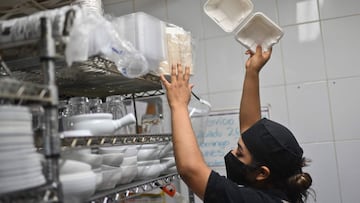How to apply for second round of PPP loans for small businesses
Congress renewed the Paycheck Protection Program allowing some businesses to apply for a second round of assistance. Here’s what you need to know to apply.

As part of the covid-19 relief bill passed by Congress in December a new round of Paycheck Protection Program (PPP) loans was approved. Some businesses will be eligible for a second forgivable loan with some of the rules changing for the better.
The bill includes a total of $284.5 billion for PPP loans with the focus on low to moderate income areas. Congress specifically designated $137 billion for Second Draw loans as part of a $900 billion coronavirus relief bill signed into law on 27 December.
When will the PPP loans be available?
The Paycheck Protection Program is run by the Small Business Administration (SBA) but the loans will be made available through local lenders. In a statement the SBA says that its loan portal is now open to First Draw PPP loan applications from participating community financial institutions (CFI) which made up roughly 10 percent of participating lenders in 2020. A First Draw PPP loan is for those borrowers who have yet to receive a PPP loan before the program closed in August 2020.
Participating CFIs will be able to submit application information for Second Draw PPP loans starting 13 January. A Second Draw PPP loan is for certain eligible borrowers that previously received a PPP loan.
First and Second Draw PPP loan applications from additional lenders will open a few days later.
SBA plans to dedicate specific times to process and assist the smallest PPP lenders with loan applications from eligible small businesses.
Businesses that want to take advantage of the program will need to act and gather the necessary paperwork as the program closes on 31 March, 2021
✅ #PaycheckProtection Program
— #SmallBusinessWeek is May 1 - 7 (@SBAgov) January 13, 2021
✅ #COVID19 Economic Injury Disaster Loans
➡️ See what pandemic relief options are available for your #smallbiz:
How to apply for the Paycheck Protection Program
For small businesses applying for a PPP loan will need to submit documents to verify their payroll costs and revenue loss. The documents include tax forms, bank statements and a color copy of a government ID. Applicants for a Second Draw PPP loan can avoid paperwork by using the same lender as the First Draw loan, provided the business uses payroll figures from 2019.
Borrowers requesting $150,000 or less don’t need to prove revenue loss when they apply for a PPP loan but will need to do so to apply for loan forgiveness. The business would have to fill out a one-page form provided by the lender estimating the total amount of the loan spent on forgivable expenses. However such borrowers would need to show that they have restored full-time employees salaries and wages to levels prior to 15 February, 2020.
Business owners who borrow more than $150,000 will need to show the same documentation as in the first round of PPP loans. This includes showing how the money was spent which may include payroll expenses and head count, operating costs and supplier costs. In the second round additional expenses are contemplated for PPP loan forgiveness.
SBA district offices are hosting webinars on the #PaycheckProtection Program, #COVID19 Economic Injury Disaster Loans, & other relief options. Stay updated on the webinars by:
— #SmallBusinessWeek is May 1 - 7 (@SBAgov) January 12, 2021
📧Subscribing to email alerts: https://t.co/vxlK62oQdw
📱Following this list: https://t.co/YX8bRB7TH2 pic.twitter.com/8PiBRRVrZ8
The rules for forgiveness of a PPP loan
The biggest selling point of the PPP loan program is that PPP loans are forgivable. To get forgiveness a business must incur certain expenses over an 8- or 24-week period from receiving the loan, the business determines the time period. The loan is forgiven when an employer documents that the money has been used properly.
The same core expenses are still included in the forgiveness calculation. These include payroll and related costs such as rent and mortgage interest as well as group health insurance. New this time round businesses can also include expenses related to last year’s riots that weren’t covered by insurance and costs incurred for meeting government regulations for the covid-19 pandemic.
The forgiveness calculation is still 60 percent for payroll and 40 percent for non-payroll. Because of rule changes some borrowers may be entitled to borrow more than they did with the previous PPP loan if they didn't take out the full amount available to them. Those businesses can go back to their lender and have their original loan value changed regardless if the loan has been fully disbursed or not, so long as they haven’t already applied for forgiveness.
Related stories
If the loan is not forgiven, these loans would have an interest rate of 1% and a term of five years. Loan payments are deferred for 10 months after the covered period ends or when you receive a forgiveness verdict, whichever comes first.
To find out what businesses are eligible and how much money a business can apply for click here.


